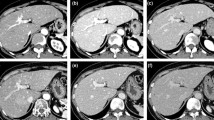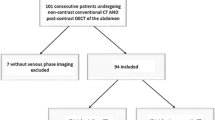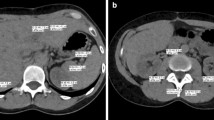Abstract
The aim of this study was to determine if a saline solution flush following low dose contrast material bolus improves parenchymal and vascular enhancement during abdominal multiple detector-row computed tomography (MDCT). Forty-one patients (24 men and 17 women; mean age 49 years, age range 27–86 years) underwent abdominal MDCT (collimation 4×5 mm, 15-mm table increment, reconstruction interval 5 mm, gantry rotation period 0.8 s) with a single- as well as with a double syringe power injector. Indication for examination were benign and malignant tumors and inflammatory diseases. Patients received 100 ml nonionic contrast material (300 mgI/ml) alone or pushed with 20 ml saline solution. Mean enhancement values for both protocols were measured in the liver, the spleen, the pancreas, the renal cortex, the portal vein, the inferior vena cava and the abdominal aorta. Double syringe power-injector protocol led to significantly higher parenchymal and vascular enhancement than single syringe power-injector protocol (p<0.05). The improvement in mean enhancement of the liver was 9±9 HU, of the spleen 8±10 HU, of the pancreas 7±9 HU, and of the renal cortex 8±20 HU. The improvement in mean enhancement of the portal vein was 10±17 HU of the inferior vena cava 8±13 HU and of the abdominal aorta 10±17 HU. The use of a double syringe power injector with saline flush following contrast material bolus significantly improves parenchymal and vascular enhancement during contrast-enhanced abdominal MDCT with low iodine doses.


Similar content being viewed by others
References
Rubin GD, Shiau MC, Schmidt AJ, Fleischmann D, Logan L, Leung AN, Jeffrey RB, Napel S (1999) Computed tomographic angiography: historical perspective and new state-of-the-art using multi detector-row helical computed tomography. J Comput Assist Tomogr 23 (Suppl 1):S83–S90
Chambers TP, Baron RL, Lush RM (1994) Hepatic CT enhancement. Part II. Alterations in contrast material volume and rate of injection within the same patients. Radiology 193:518–522
Chambers TP, Baron RL, Lush RM (1994) Hepatic CT enhancement. Part I. Alterations in the volume of contrast material within the same patients. Radiology 193:513–517
Kim S, Kim JH, Han JK, Lee KH, Min BG (2000) Prediction of optimal injection protocol for tumor detection in contrast-enhanced dynamic hepatic CT using simulation of lesion-to-liver contrast difference. Comput Med Imaging Graph 24:317–327
Debatin JF, Cohan RH, Leder RA, Zakrzewski CB, Dunnick NR (1991) Selective use of low-osmolar contrast media. Invest Radiol 26:17–21
Halpern JD, Hopper KD, Arredondo MG, Trautlein JJ (1996) Patient allergies: role in selective use of nonionic contrast material. Radiology 199:359–362
Hopper KD (1996) With helical CT, is nonionic contrast a better choice than ionic contrast for rapid and large IV bolus injections? Am J Roentgenol 166:715
Bluemke DA, Fishman EK, Anderson JH (1994) Dose requirements for a nonionic contrast agent for spiral computed tomography of the liver in rabbits. Invest Radiol 29:195–200
Freeny PC, Gardner JC, von Ingersleben G, Heyano S, Nghiem HV, Winter TC (1995) Hepatic helical CT: effect of reduction of iodine dose of intravenous contrast material on hepatic contrast enhancement. Radiology 197:89–93
Megibow AJ, Jacob G, Heiken JP, Paulson EK, Hopper KD, Sica G, Saini S, Birnbaum BA, Redvanley R, Fishman EK (2001) Quantitative and qualitative evaluation of volume of low osmolality contrast medium needed for routine helical abdominal CT. Am J Roentgenol 176:583–589
Sadick M, Lehmann KJ, Diehl SJ, Wild J, Georgi M (1997) Bolus tracking and NaCl bolus in biphasic spiral CT of the abdomen. Rofo Fortschr Geb Rontgenstr Neuen Bildgeb Verfahr 167:371–376
Brink JA, Heiken JP, Forman HP, Sagel SS, Molina PL, Brown PC (1995) Hepatic spiral CT: reduction of dose of intravenous contrast material. Radiology 197:83–88
Hanninen EL, Vogl TJ, Felfe R, Pegios W, Balzer J, Clauss W, Felix R (2000) Detection of focal liver lesions at biphasic spiral CT: randomized double-blind study of the effect of iodine concentration in contrast materials. Radiology 216:403–409
Herts BR, Paushter DM, Einstein DM, Zepp R, Friedman RA, Obuchowski N (1995) Use of contrast material for spiral CT of the abdomen: comparison of hepatic enhancement and vascular attenuation for three different contrast media at two different delay times. Am J Roentgenol 164:327–331
Kim T, Murakami T, Takahashi S, Okada A, Hori M, Narumi Y, Nakamura H (1999) Pancreatic CT imaging: effects of different injection rates and doses of contrast material. Radiology 212:219–225
Small WC, Nelson RC, Bernardino ME, Brummer LT (1994) Contrast-enhanced spiral CT of the liver: effect of different amounts and injection rates of contrast material on early contrast enhancement. Am J Roentgenol 163:87–92
Yamashita Y, Komohara Y, Takahashi M, Uchida M, Hayabuchi N, Shimizu T, Narabayashi I (2000) Abdominal helical CT: evaluation of optimal doses of intravenous contrast material: a prospective randomized study. Radiology 216:718–723
Sandstede JJ, Tschammler A, Beer M, Vogelsang C, Wittenberg G, Hahn D (2001) Optimization of automatic bolus tracking for timing of the arterial phase of helical liver CT. Eur Radiol 11:1396–1400
Hopper KD, Mosher TJ, Kasales CJ, TenHave TR, Tully DA, Weaver JS (1997) Thoracic spiral CT: delivery of contrast material pushed with injectable saline solution in a power injector. Radiology 205:269–271
Haage P, Schmitz-Rode T, Hubner D, Piroth W, Gunther RW (2000) Reduction of contrast material dose and artifacts by a saline flush using a double power injector in helical CT of the thorax. Am J Roentgenol 174:1049–1053
Levi C, Gray JE, McCullough EC, Hattery RR (1982) The unreliability of CT numbers as absolute values. Am J Roentgenol 139:443–447
Author information
Authors and Affiliations
Corresponding author
Rights and permissions
About this article
Cite this article
Schoellnast, H., Tillich, M., Deutschmann, H.A. et al. Improvement of parenchymal and vascular enhancement using saline flush and power injection for multiple-detector-row abdominal CT. Eur Radiol 14, 659–664 (2004). https://doi.org/10.1007/s00330-003-2085-3
Received:
Revised:
Accepted:
Published:
Issue Date:
DOI: https://doi.org/10.1007/s00330-003-2085-3




